
The idea of weaving an artwork from palm husks came to Amina Agueznay during a workshop she was leading in Morocco’s Souss-Massa region, as part of a project with local rug weavers to renovate Tissekmoudine, a ksar, or fortified village.
“The plan was to integrate the palm trees from the oasis in our designs, so I encouraged the women to look around them and use whatever material they could find,” says Agueznay, who this month won the Norval Sovereign African art prize, worth $35,000 (£28,000).
“We decided to weave with what, in the Berber language, the women call talefdamt [palm husk],” Agueznay recalls. “We deconstructed it to create a thread that we could use.”
The winning work, Portal #1, is reminiscent of a jagged-edge motif found on Moroccan rugs and inspired by the symbols painted on the doors of a ksar.
The architect turned artist, who is known for collaborating with rural craftworkers and documenting their designs and traditions, says she feels “blessed” by the win.
“This prize is an encouragement and the will to continue, empowering women that I work with. I lead workshops throughout Morocco and what happens is that I always go back. There is a continuity, and continuity is very important to me – what we call la pérennité [sustainability].
“I would call it a constellation,” says Agueznay. “It’s like building another family.”
Born in 1963, she is the daughter of Malika Agueznay, who is among Morocco’s first female modernist abstract artists and a member of the celebrated Casablanca Art School.
Moving to the US for 15 years after school, Agueznay studied architecture in Washington and practised there and in New York before returning to Morocco in 1997. She started working on smaller-scale projects, such as jewellery, before expanding to large art installations.
“I returned to Morocco to explore scale in a meaningful way,” Agueznay says. “I can’t hug my buildings, but I can hug my artwork.”
***
Ksars, fortified villages found across the Maghreb, are made of stone and adobe with palm grove gardens. Some are ruined, but many are being renovated as part of a national push to preserve Morocco’s cultural heritage.
Agueznay was invited to get involved with local people in the project to renovate the Tissekmoudine ksar by the architect and anthropologist Salima Naji, who works on using traditional materials and techniques in such renovations.
Agueznay says she drew a door and asked six women to weave for her. “It’s all a performative process,” she says. “It’s like choreography or ballet for me.”
“It’s about the intangible and the tangible. The piece is tactile – you want to touch it, you want to smell it,” she says.
“It has the smell of the oasis, the palm husk. The tangible is the oeuvre, the final piece that you have in front of you, and yet the stories and the process remain intangible.”
A total of 375 works by 160 artists were entered for this year’s prize, organised in South Africa by the Norval Foundation and the Sovereign Art Foundation (SAF). The 27 finalists come from 17 countries, including South Africa, Egypt, Ethiopia, Ghana, Nigeria and Senegal.
Ashraf Jamal, a Cape Town-based academic who was one of the judges, said they had chosen “an artist with an enduring vision of the lives and triumphs of women of the African desert”.
As well as the prize money, Agueznay will have a solo exhibition at the Norval Foundation art museum in Cape Town and an artist’s residency in London supported by the Outset Contemporary Art Fund.
Agueznay, who is represented by the Loft Art Gallery in Casablanca and Marrakech, had an artistic residency at Fondation H in Madagascar last year, where she was inspired by the Malagasy artist Madame Zo, who was celebrated for her textile artworks.
“Weaving is interesting because it’s about going back to the line,” she says. “The line is important for me because of my practice as an architect – I always go back to my architectural primary elements of form: lines, planes and volumes.”
Agueznay says she thinks what comes out of Africa artistically is “always surprising”.
“It’s always new,” she says, “and for a curious person like me that’s what makes the magic.”







